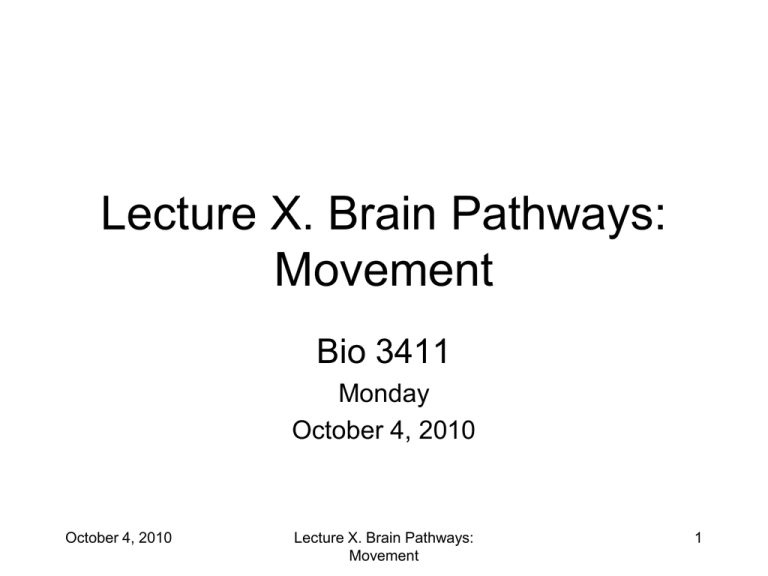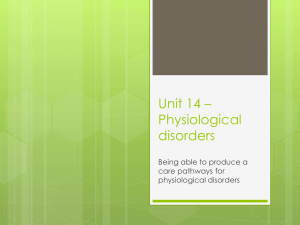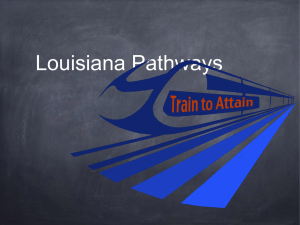X_Movement 10-4
advertisement

Lecture X. Brain Pathways: Movement Bio 3411 Monday October 4, 2010 October 4, 2010 Lecture X. Brain Pathways: Movement 1 Readings (background only) Neuroscience 4th ed Page(s) Feature 423-451 Upper motor control of Brain Stem and Spinal Cord The Brain Atlas 3rd ed Page(s) Feature 198-199 Vestibular Pathways 200-201 Direct Corticospinal tract 202-203 Rubrospinal and Tectospinal tracts 204-205 Reticulospinal Pathways October 4, 2010 Lecture X. Brain Pathways: Movement 2 References †Gleeson, J. G., Keeler, L. C., Parisi, M. A., Marsh, S. E., Chance, P. F., Glass, I. A., Graham Jr, J. M., Maria, B. L., Barkovich, A. J., & Dobyns, W. B. (2004). Molar tooth sign of the midbrain-hindbrain junction: occurrence in multiple distinct syndromes. Am J Med Genet A, 125A(2), 125-134; discussion 117. †Sicotte, N. L., Salamon, G., Shattuck, D. W., Hageman, N., Rub, U., Salamon, N., Drain, A. E., Demer, J. L., Engle, E. C., Alger, J. R., Baloh, R. W., Deller, T., & Jen, J. C. (2006). Diffusion tensor MRI shows abnormal brainstem crossing fibers associated with ROBO3 mutations. Neurology, 67(3), 519-521. †Tovar-Moll, F., Moll, J., Bramati, I. E., de Souza, A. S., Andreiuolo, P. A., & de Oliveira-Souza, R. (2007). The human pyramidal syndrome Redux. Neuroreport, 18(14), 1417-1421. †Vulliemoz, S., Raineteau, O., & Jabaudon, D. (2005). Reaching beyond the midline: why are human brains cross wired? Lancet Neurol, 4(2), 87-99. _________________ †(pdfs on course websites: [http://artsci.wustl.edu/~bio3411/] & [http://www.nslc.wustl.edu/courses/Bio3411/bio3411.html] October 4, 2010 Lecture X. Brain Pathways: Movement 3 What the last Lecture was About Sensory Transduction Receptive Fields Adaptation Feature Detection Maps Sensory Integration October 4, 2010 Lecture X. Brain Pathways: Movement 4 Overview Corticospinal Tract: Activation & Somatotopy Activity of Motor Cortex Neurons Directs Movement: Force & Direction Four Other Motor Pathways to Spinal Cord Role(s) of Descending Pathways in Movement Control Effects of Corticospinal Tract Lesion Why is left right, and right left? October 4, 2010 Lecture X. Brain Pathways: Movement 5 Corticospinal (Pyramidal) Pathway. This is the direct connection from the cerebral cortex for control of fine movements in the face and distal extremities, e.g., buttoning a jacket or playing at trumpet. October 4, 2010 Lecture X. Brain Pathways: Movement 6 THE BRAIN ATLAS 3rd, pp. 36, 43 Corticospial Tract (Pyramid) at Medulla October 4, 2010 Lecture X. Brain Pathways: Movement 7 THE BRAIN ATLAS, 3rd ed., p. 147 Pyramidal Tracts Cross Section Through Human Medulla October 4, 2010 Lecture X. Brain Pathways: Movement 8 THE BRAIN ATLAS 3rd ed, pp. 20, 201 October 4, 2010 Lecture X. Brain Pathways: Movement 9 Normal Pyramid Cartoons of movements evoked by direct cortical stimulation. The shading indicates the joint(s) moved. Electrical stimulation of different points in motor cortex with small currents (thresholds) causes different movements October 4, 2010 Currents required to just provoke the above movements (threshold). Lecture X. Brain Pathways: Movement 10 The left hemisphere of the monkey brain - Motor (Ms) and Somatosensory (Sm) Maps October 4, 2010 Lecture X. Brain Pathways: Movement 11 A neuron in the motor cortex of of an awake behaving monkey fires when the wrist is extended (red arrow in diagram above). It fires more when more force is required (flexors loaded) and not at all if no contraction is needed to extend the rest (extensors loaded). October 4, 2010 Lecture X. Brain Pathways: Movement 12 Each small vertical line marks an action potential of the neuron. A neuron in the motor cortex of of an awake behaving monkey fires in relation to the direction of the movement (see “tuning” curve - left). October 4, 2010 Lecture X. Brain Pathways: Movement 13 Sources of Descending Pathways for Movement Control 1. 1. Forebrain (Cortex) 2. Midbrain (Red Nucleus & Superior Colliculus) 2. 3. 3. Pons (Reticular Formation) 4. Medulla (Reticular Formation and Vestibular Nuclei) October 4, 2010 4. Lecture X. Brain Pathways: Movement 14 THE BRAIN ATLAS, 3rd ed, p. 203 Rubrospinal Pathway. This pathway (from the red nucleus) mediates voluntary control of movements, excepting the fine movements of the fingers, toes and mouth. October 4, 2010 Lecture X. Brain Pathways: Movement 15 THE BRAIN ATLAS, 3rd ed, p. 203 Tectospinal Pathway. This pathway (from the superior colliculus) mediates head and body orientation in response to localized visual, auditory and tactile stimuli, often from the same source. October 4, 2010 Lecture X. Brain Pathways: Movement 16 THE BRAIN ATLAS, 3rd ed, pp. 199, 205 Vestibulospinal Pathways. Reticulospinal Pathways. These pathways (from the vestibular nuclei) mediates head and body orientation in response to changes in head linear and angular velocity and with respect to gravity . These pathways carry information from the brain stem reticular formation to the spinal cord to stabilize movement on uneven surfaces. October 4, 2010 Lecture X. Brain Pathways: Movement 17 Descending systems from the brain influence cells in the spinal cord to create movements. The cerebellum and the basal ganglia indirectly influence movements as indicated schematically here. October 4, 2010 Lecture X. Brain Pathways: Movement 18 NEUROSCIENCE (1st ed), p. 319, Fig 16.8 Other cortical areas influence the initiation of movements to achieve particular goals through specific sequences, as in playing a scale on the piano. These areas are also activated when a person is instructed to think about performing the sequence without actually moving. October 4, 2010 Lecture X. Brain Pathways: Movement 19 THE BRAIN ATLAS 3rd ed, pp. 36, 43 Corticospial Tract (Pyramid) at Medulla October 4, 2010 Lecture X. Brain Pathways: Movement 20 October 4, 2010 Lecture X. Brain Pathways: Movement 21 After the pyramid was cut (lesioned) the opposite hand (the right hand) was used to try to get food from a well but all fingers were used. The monkey could not get food from the smallest well. October 4, 2010 The hand opposite the normal pyramid (the left hand) was used to get food from the small well by opposing the thumb and fore finger. The monkey got the food from the smallest well. Lecture X. Brain Pathways: Movement 22 Cut Pyramid Normal Pyramid Electrical After the pyramid stimulation of was cut the different points movements were in motor cortex with small coarser and the currents currents required (thresholds) causes to produce them different were larger. movements October 4, 2010 Lecture X. Brain Pathways: Movement 23 Pyramid (CST) Normal Pathological (Tovar-Moll et al., 2007) October 4, 2010 Lecture X. Brain Pathways: Movement 24 Pyramid (CST) Normal Pathological (Tovar-Moll et al., 2007) October 4, 2010 Lecture X. Brain Pathways: Movement 25 The corticospinal (pyramidal) tract controls fine movements particularly of the lips, fingers and toes. When it is cut, other descending pathways such as the rubrospinal pathway can be used for grasping movements. These lack the precision of those activated by the corticospinal pathway and the monkey cannot pickup its food. October 4, 2010 Lecture X. Brain Pathways: Movement 26 Relative Size of Different Brain Parts In Phylogeny The forebrain becomes relatively larger as new pathways (functions) are added. October 4, 2010 Lecture X. Brain Pathways: Movement 27 Why are brain pathways “crossed”? Ramón y Cajal suggested that brain pathways are crossed to preserve the appropriate relationships after optical inversion by the lens as indicated schematically by the arrows in the uncrossed (left) and the crossed (right) visual pathways. S. Ramón y Cajal, (1911) Histology of the Nervous System, Volume II. (English translation by N. & L. Swanson, Oxford: New York pp 309-310, 1995). October 4, 2010 Lecture X. Brain Pathways: Movement 28 HGPS (horizontal gaze paralysis and progressive scoliosis) (Vulliemoz, Raineteau, & Jabaudon, 2005) October 4, 2010 Lecture X. Brain Pathways: Movement 29 What this Lecture was about Corticospinal Tract: Activation & Somatotopy Activity of Motor Cortex Neurons Directs Movement: Force & Direction Four Other Motor Pathways to Spinal Cord Role(s) of Descending Pathways in Movement Control Effects of Corticospinal Tract Lesion Why is left right, and right left? October 4, 2010 Lecture X. Brain Pathways: Movement 30 END October 4, 2010 Lecture X. Brain Pathways: Movement 31




